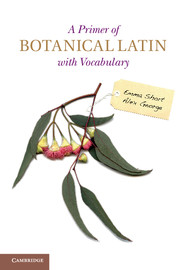Brown, R. W. (1956, reprinted 1978). Composition of Scientific Words. Washington, DC: Smithsonian Institution Press.
Collins Latin Dictionary plus Grammar (1997). [London]: HarperCollins Publishers.
Kennedy, B. H., revised by Bartram, J. W. (1931). The Shorter Latin Primer, new edn. London, New York etc.: Longmans, Green and Co.
Lack, H. W. (2011). Botanical Latin today. Chapter 10. In Monographic Plant Systematics: Fundamental Assessment of Plant Biodiversity, ed. Stuessy, T. F. and Lack, H. W.. Regnum Vegetabile 153, Ruggell: A.R.G.Gantner Verlag K.G., pp. 179–190.
McNeill, J., Barrie, F. R., Burdet, H. M. et al. (2006). International Code of Botanical Nomenclature (Vienna Code) adopted by the Seventeenth International Botanical Congress, Vienna, Austria, July 2005. Ruggell, Lichtenstein: A.R.G. Ganter Verlag.
McNeill, J., Barrie, F. R., Buck, W. R. et al. (2012). International Code of Nomenclature for Algae, Fungi and Plants (Melbourne Code) adopted by the Eighteenth International Botanical Congress, Melbourne, Australia, July 2011. Königstein: Koeltz Scientific Books.
Stearn, W. T. (1992). Botanical Latin, 4th edn. Newton Abbot, Devon: David & Charles.
Further readingAnonymous (1993). Flora of Australia Guide for Contributors, 3rd edn. Canberra: Australian Biological Resources Study.
Beentje, H. (2010). The Kew Plant Glossary: An Illustrated Dictionary of Plant Terms. Kew, Richmond: Royal Botanic Gardens.
Bon, M. (1987). The Mushrooms and Toadstools of Britain and North-western Europe. London, etc.: Domino Books, Hodder & Stoughton.
Cash, E. K. (1965). A Mycological English–Latin Glossary. New York: New York Botanical Garden in collaboration with Mycological Society of America.
Eichler, H j. (1977). Guidelines for the Preparation of Botanical Taxonomic Papers. [Canberra]: CSIRO.
Fowler, H. W. (1996). The New Fowler’s Modern English Usage, 3rd edn, ed. Burchfield, R. W.. Oxford: Clarendon Press.
George, A. S. (ed.) (1992). Flora of Australia, vol. 54, Lichens – Introduction Lecanorales 1. Canberra: AGPS Press.
Gilbertson, R. L. and Ryvarden, L. (1986). North American Polypores, vol. 1. Oslo: Fungiflora.
Grgurinovic, C. A. (1996). Glossary. In Fungi of Australia vol. 1A, Introduction–Classification, ed. Orchard, A. E.. Canberra: Australian Biological Resources Study & Melbourne: CSIRO, pp 341–378.
Gray, M. D. and Jenkins, T., edited by McEvoy, C. and Dale, F. (1934). Latin for Today: Book Two. London: Ginn and Co.
Hallegraeff, G. M., Bolch, C. J. S., Hill, D. R. A. et al. (2010). Algae of Australia: Phytoplankton of Temperate Coastal Waters. Canberra: ABRS and Melbourne: CSIRO Publishing.
Hewson, H. J. (1988). Plant Indumentum: A Handbook of Terminology, Australian Flora and Fauna Series no. 9. Canberra: Australian Government Publishing Service.
Hickey, M. and King, C. (2000). The Cambridge Illustrated Glossary of Botanical Terms. Cambridge: Cambridge University Press.
Huisman, J. M. (2000). Marine Plants of Australia. Nedlands: University of Western Australia Press and Canberra Australian Biological Resources Study.
Jones, P. V. and Sidwell, K. C. (1986). Reading Latin: Grammar, Vocabulary and Exercises. Cambridge: Cambridge University Press.
Kirk, P. M., Cannon, P. F., Minter, D. W. et al. (2008). Ainsworth & Bisby’s Dictionary of the Fungi, 10th edn. Wallingford: CAB International and Collingwood: CSIRO Publishing.
Kraft, G. (2007). Algae of Australia, Marine Benthic Algae of Lord Howe Island and the Southern Great Barrier Reef, 1. Green Algae. Canberra: Australian Biological Resources Study and Melbourne: CSIRO.
Kraft, G. (2009). Algae of Australia, Marine Benthic Algae of Lord Howe Island and the Southern Great Barrier Reef, 2. Brown Algae. Canberra: Australian Biological Resources Study and Melbourne: CSIRO.
Largent, D. (1977). How to Identify Mushrooms to Genus I: Macroscopic Features, 2nd edn, Eureka, California: Mad River Press.
Lewis, C. T. (1891, new impression 1982). An Elementary Latin Dictionary with brief Helps for Latin Readers. Oxford: Oxford University Press.
Lewis, C. T. and Short, C. (1879, reprinted many times). A Latin Dictionary founded on Andrews’ Edition of Freund’s Latin Dictionary revised, enlarged and in great part rewritten. London: Oxford University Press.
Orchard, A. E. (ed.) (1998). Flora of Australia, vol. 48, Ferns, Gymnosperms and Allied Groups. Melbourne: CSIRO Publishing and Canberra: Australian Biological Resources Study.
Orchard, A. E. (1999). Species Plantarum Flora of the World: Introduction to the Series. Canberra: Australian Biological Resources Study.
Peters, P. (1995). The Cambridge Australian English Style Guide. Cambridge: Cambridge University Press.
Philips, R. (1981). Mushrooms and other Fungi of Great Britain and Europe. London: Pan Books Ltd.
Radcliffe-Smith, A. (1998). Three-language List of Botanical Name Components. Kew: Royal Botanic Gardens.
Ramsay, H. P. (2006). Glossary. In Flora of Australia, vol. 51, Mosses 1, ed. McCarthy, P. M.. Canberra: Australian Biological Resources Study and Melbourne: CSIRO, pp. 413–429.
Raven, P. H., Evert, R. F. and Curtis, H. (1981). Biology of Plants, 3rd edn. New York: Worth Publishers Inc.
Ross, R., Cox, E. J., Karayeva, N. I. et al. (1979). An Amended Terminology for the Siliceous Components of the Diatom Cell, Nova HedwigiaBeiheft 64, pp 513–533.
Simpson, D. P. (1959). Cassell’s New Latin–English English–Latin Dictionary, & later edns. London: Cassell & Co. Ltd.





